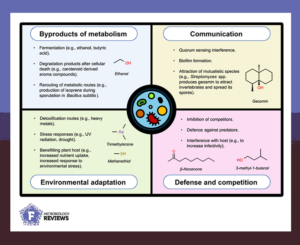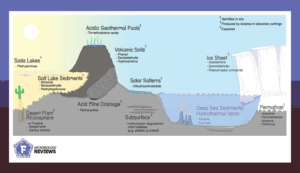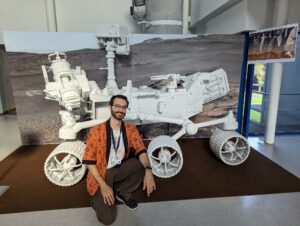Until the first half of the 20th century, scientists assumed that places like acidic lakes and volcanic hot springs would be devoid of any life due to their extreme conditions. However, the discovery of the bacterium Thermus aquaticus in a hot spring in Yellowstone National Park in 1969 marked a turning point in our understanding of microbial resilience. Today, we know that many extreme environments are actually teeming with life! The review “Extreme smells – microbial production of volatile organic compounds at the limits of life” in FEMS Microbiology Reviews highlights a fascinating group of metabolites produced by extremophiles and their potential applications, as discussed by Miguel Ángel Salinas-García. #MicrobiologyIsEverywhere
Extremophile organisms love the extreme
Extreme organisms thrive in boiling volcanic springs, hyperacidic, hyperalkaline, and hypersaline lakes, or deep beneath the Earth’s crust. To cope with harsh environmental stressors, they have evolved special adaptations, such as cellular membranes and enzymes that remain functional at high temperatures.
To interact with each other and the world around them, microorganisms developed a chemical language including volatile organic compounds. These molecules easily diffuse and evaporate thanks to their small size and lack of interactions with water molecules. Microbes use these molecules to both communicate and deal with stress. Volatile organic compounds are widely found throughout the tree of life: some examples include geosmin (the smell of wet soil), pinene (pine trees), and methanethiol (rotten cabbage).

Extreme environments make for extreme smells
The review “Extreme smells – microbial production of volatile organic compounds at the limits of life” in FEMS Microbiology Reviews highlights microorganisms that produce volatile organic compounds in extreme environments.
For example, algae growing on snow and ice produce dozens of compounds with potential antifungal properties, keeping competition away. In contrast, microbes in hot volcanic soils feed on volatile compounds produced through volcanic activity, releasing different volatile organic compounds in turn.
In acidic streams, Ferroplasma acidarmanus produces sulphur-containing volatile organic compounds, which could be important for sulphur cycling in its native environment. On the other side of the pH scale, Spirulina and other algae in alkaline lakes produce dozens of different volatile organic compounds.
In hypersaline lake sediments, however, the presence of volatile organic compounds in different layers gives clues about the ancient climate of the lake and the microorganisms that inhabited it across long periods of time. Similarly, in deep-sea sediments, volatile organic compounds can indicate microbial metabolic activities.
In comparison, in deserts, microbes near plant roots use volatile organic compounds to alleviate drought stress of their plant hosts. This improves their odds of survival when water availability is low. Additionally, in the presence of heavy metals, such as arsenic, extremophiles can incorporate these into volatile organometallic compounds to detoxify and lessen the toxic stress.

Extreme smells for extreme applications
The lessons learned from extremophiles and their volatile organic compounds have promising practical applications. For example, the interactions between desert plants and bacteria mediated by volatile organic compounds could help improve agriculture in drylands. Exploiting inhibitory volatile organic compounds might even function as biological alternatives to pesticides.
Astrobiologists have also become interested in volatile organic compounds as potential biosignatures – signs of life – because they are relatively easy to sample. High-resolution chemical analysis could be used in the search for life on Mars, the Jupiter moon Europa, and beyond. Volatile organic compounds could even offer clues about the ecosystems of Early Earth.
So far, we have only identified a small fraction of volatile organic compounds produced by microorganisms. This fraction is likely even smaller for extremophiles.
Extremophiles have provided us with efficient biofactories, enzymes for everything from doing our laundry to copying DNA, and even biomining operations. Studying volatile organic compounds by extremophiles could lead us to the next big breakthrough, perhaps even helping us detect the smell of life in the universe.
- Read the review “Extreme smells – microbial production of volatile organic compounds at the limits of life” by Salinas-García et al. (2025) in FEMS Microbiology Reviews.
About the author of this blog

Miguel Ángel Salinas-García is a Spanish biologist by trade and Earthling astrobiologist by heart. He defended his PhD in December 2024 on the production of VOCs by extremophilic bacteria, and how this information could be used in the search for life on other planets. After studying Biology and Biotechnology in Madrid, Spain, he moved to Copenhagen to do his PhD with Prof. Anders Priemé. He enjoys anything related to space, extremophiles, climate change, and tabletop role-playing games.
About this blog section
The section #MicrobiologyIsEverywhere highlights the global relevance of microbiology. The section acknowledges that microbiology knows no borders, as well as the fact that microbiologists are everywhere and our FEMS network extends well beyond Europe. This blog entry type accepts contributions from excellent blogs translated into English. Regional stories with global relevance are welcomed. National or international events sponsored, organised or connected to FEMS are also covered.
| Do you want to be a guest contributor? |
| The #FEMSmicroBlog welcomes external bloggers, writers and SciComm enthusiasts. Get in touch if you want to share your idea for a blog entry with us! |
